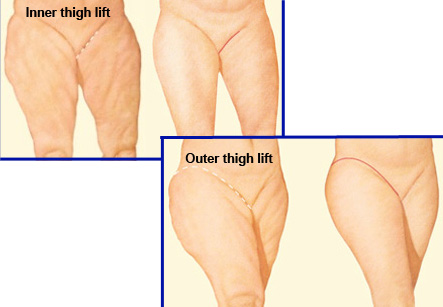Thigh Lift
Introduction
A thigh lift is a procedure to reshape the thighs by reducing excess skin, and in some cases fat, which results in smoother skin and better-proportioned contours of the thighs and lower body. case if the fitness and weight loss programmes have not achieved the goals for a firmer, more youthful-looking and more proportionate body, the patient is a suitable candidate for a surgical thigh lift. This surgery reshapes the thighs by reducing excess skin, and in some cases fat.
After completion of the procedure, the wounds are covered by applying dressing or bandages.
The contours of the lower body are also improved as thighs are an important part of lower body in regard to the proportion of lower body. Liposuction alone can remove excess fat in the areas where skin has good elasticity and is able to naturally adjust to new body contours. However, if the skin elasticity is poor, a combination of liposuction and thigh lift techniques is a preferred option.
Indications:
There are some requirements which make the patient more suitable for the thigh lift procedure. These are as follows:
1. Person whose weight is relatively stable.
2. Individuals having extra soft tissue along the inner or medial thigh region and also the outer thigh.
We have all the information you need about public and private Cosmetic / Plastic clinics that provide Thigh Lift in Iran, Islamic Republic Of

3. Individuals in good general health who do not have other medical conditions which can impair healing or increase the risk for undergoing surgery
4. Person in sound mental status
5. Non-smokers
6. Individuals who have a positive outlook and realistic goals regarding the possible results of thigh lift surgery.
7. Individuals committed to a future healthy lifestyle including proper nutrition and fitness.
Procedure
Step 1 - Anesthesia:
The choices for anesthesia in the thigh lift surgery include intravenous sedation and general anesthesia. Medications for sedation comfort the patient during on-going surgical procedure.
Step 2 – The incision
• Incision patterns are dependent on the area or areas to be treated, degree of correction required and patient as well as surgeon preference.
• Usually, the technique used for a thigh lift involves taking incisions in the groin and extending it downward wrapping around the back of the thigh. The underlying tissue is reshaped and tightened, and skin is also reduced and tightened resulting in more proportionate and smoother body contours.
• A minimal invasive surgery involves incision only in the groin area. This is performed for a medial thigh lift. The surgeon decides which approach is appropriate.
• An incision extending from the groin and going around the hip is utilized for improving the contours of the outer thigh.
• Through these incisions the plastic surgeon creates a smoother, better-toned lower body contour by various tightening methods.
• Advanced techniques in this field allow incisions to be placed in strategic locations where they are not apparent in most types of clothing and swimsuits. However, incisions may be large and extensive.
Step 3 – Closing the incisions
• Deep support sutures are taken in underlying tissues to form the newly shaped contours. Skin incisions are also closed with sutures.
Results:
• The smoother and tighter contouring resulting from a thigh lift are apparent almost immediately. Initially, however, the effects are obscured by some swelling and bruising.
• A compression garment is given to the patient to wear for several weeks following the procedure to minimize swelling and support the healing tissues.
• Quality of skin improves significantly after a thigh lift, both in appearance and feel.
Recovery
After completion of the procedure, the wounds are covered by applying dressing or bandages. The patient may be wrapped in an elastic bandage or made to wear a compression garment to minimize swelling and also to support the new thigh contours till healing process makes it permanent.
One or more small, thin tubes called as drains may be temporarily placed under the skin to drain any fluid or blood that might collect in the wound. They are removed after a few days.
Specific instructions are given to the patient regarding how to care for the surgical site(s) after the surgery, any medications to apply or take orally for assisting the healing and how to reduce the risk of infection. Follow-up visit with the plastic surgeon is arranged for further care.